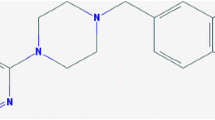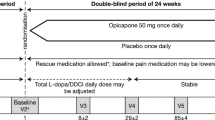Abstract.
Background: and objectives Ropinirole is a non-ergoline, selective dopamine D2 agonist. The aim of this study was to evaluate the efficacy and safety of ropinirole as an adjunct to levodopa in the treatment of Parkinson's disease (PD) complicated by motor fluctuations. Methods: A total of 76 patients with PD (Hoehn and Yahr stage II to IV) were included in this trial. Each patient was randomly allocated to receive either ropinirole (n = 37) or bromocriptine (n = 39) as an adjunct to levodopa over a 16-week period. Ropinirole and bromocriptine were titrated for optimal efficacy and tolerability. This optimal dose was then maintained for the rest of the study. Response rate was defined as the percentage of patients who achieved at least a 20 % reduction in levodopa dose. Clinical status was also assessed using the Unified Parkinson's Disease Rating Scale (UPDRS), Clinical Global Impression (CGI), and reduction in time spent ‘off’. Results: Ropinirole produced a significantly greater response rate than bromocriptine (odds ratio 2.995, 95 % C. I. (1.157, 7.751) p < 0.05). There was also a statistically significant difference between the groups in the proportion of patients who were ‘improved’ on the CGI improvement scale (91.9 % for ropinirole, 74.3 % for bromocriptine, p = 0.046). Other measures, including at least a 20 % improvement in the UPDRS motor score (70 % for ropinirole and 63.3 % for bromocriptine), and a 20 % reduction in ‘off’ duration (81 % for ropinirole and 52.4 % for bromocriptine) showed a trend in favour of ropinirole. There was no significant difference between the two groups in the overall incidence of adverse effects (ropinirole, 59.5 %; bromocriptine, 59 %). In each group, the most common side-effects were dizziness, dyskinesia and nausea/vomiting. No patients were withdrawn from the study because of side-effects. Conclusion: Ropinirole was found to be safe and well-tolerated. Ropinirole as an adjunct to levodopa in the treatment of PD with motor fluctuation was associated with more significant reduction of levodopa dose and, on one form of analysis, with significantly greater improvement in CGI ratings than bromocriptine. On the other efficacy measures the two drugs were comparable.
Similar content being viewed by others
Author information
Authors and Affiliations
Additional information
Received: 4 September 2001, Received in revised form: 8 May 2002, Accepted: 31 July 2002
This study was supported by SmithKline Beecham Korea and presented at the XIII International Congress on Parkinson's Disease, Vancouver, Canada, July 24–28, 1999.
Correspondence to Joo-Hyuk Im, MD
Rights and permissions
About this article
Cite this article
Im, JH., Ha, JH., Cho, IS. et al. Ropinirole as an adjunct to levodopa in the treatment of Parkinson's disease . J Neurol 250, 90–96 (2003). https://doi.org/10.1007/s00415-003-0937-z
Issue Date:
DOI: https://doi.org/10.1007/s00415-003-0937-z




